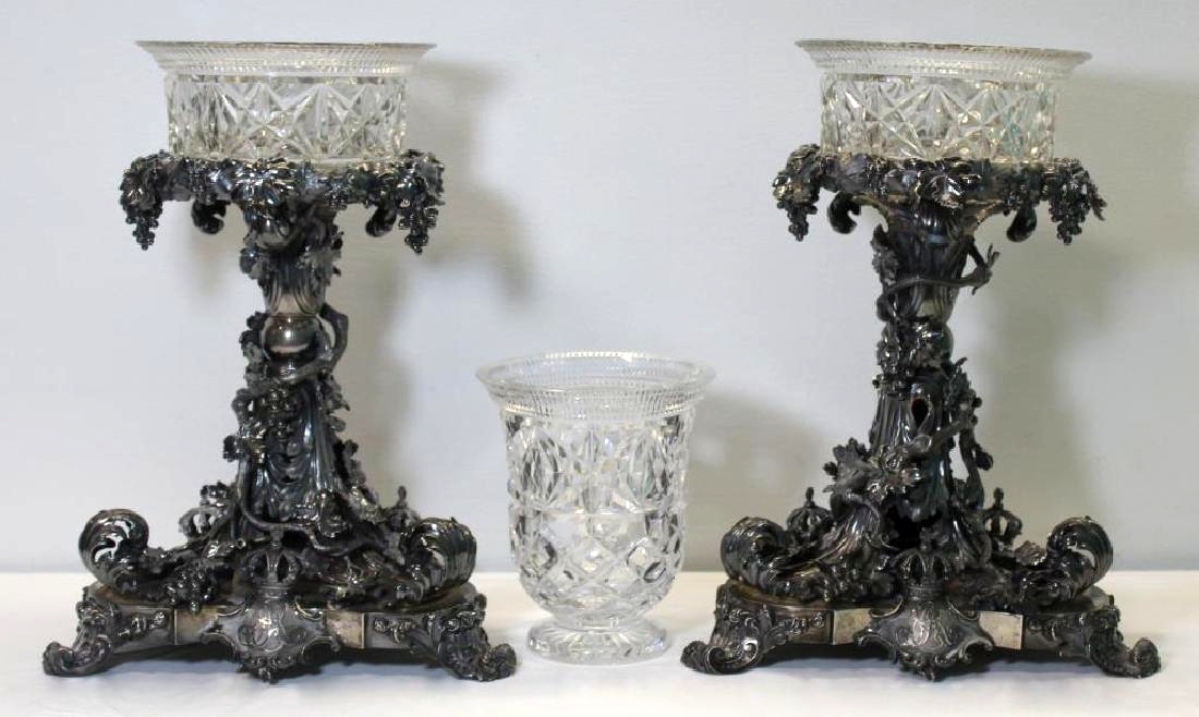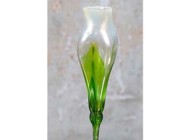
The top lot in the sale, this pair of silver center bowls was made in the workshop of London silversmiths John Mortimer and John Samuel Hunt. With exceptional detail, impressed royal insignias and overflowing foliate, the pair sold to the highest bidder at $26,250.
Review by Greg Smith, Photos Courtesy Clarke Auctions
LARCHMONT, N.Y. – Shakespeare’s oft-repeated quote “All that glitters is not gold” is a veritable proof in life. But in this industry, it can take on a different meaning altogether. Because sometimes that glitter comes from silver. Clarke Auction’s July 9 sale saw a wide variety of silver, antiques and paintings top its grand list of high-performing lots as the summer doldrums took a vacation and confident bidders took their place. A number of lots finished high above expectations amid good provenance, including a bevy of offerings from a Hastings-on-Hudson estate that was once home to one of the wealthiest families in Austria at the turn of the Twentieth Century.

A remarkable American country scene, this Henry Martin Gasser painting finished on a high foot at $25,000. The dark shadows and stormy skies against a blanket of white snow proved desirable to bidders.
The top lot in the sale was a pair of elaborately worked silver English center bowls dating from 1843 that featured exceptional detail, royal insignias and more than 257 troy ounces of silver weight. The 11¼-inch-high pair began on a triangular base with scroll-form feet beneath a platform of overflowing foliate leading up and around the stem onto the uppermost platform with even more hanging foliate around a cut crystal bowl at center. The duo was made in the workshop of London silversmiths John Mortimer and John Samuel Hunt, and went out at $26,250.
“The craftsmanship was phenomenal,” said Whitney Bria, silver and jewelry specialist at Clarke. “It was a great sale for silver.”
With the one-time owners’ accessibility to the European market, the majority of silver pieces from the Hastings-on-Hudson estate were made in Austria or Germany. From Austria came the second highest performing silver lot in the sale, a garniture set with a pair of five-light candelabra and a center bowl. Each piece featured putti figures frolicking around the base, holding vines of ivy or looking up in preparation to climb the stem. At just over 252 troy ounces, the lot brought $7,500.
With a few lots hailing from the hand of Viennese silversmith Josef Carl Klinkosch, Bria posited that the family was likely collecting Klinkosch’s work at the time.
“Klinkosch was granted the Imperial Warrant in 1855,” said Bria. “Meaning he was one of the silversmiths for Emperor Franz Joseph, the emperor of Austria and later the Austro-Hungarian Empire.”
A complete eight-piece .900 silver tea service with cross-hatched design and beautifully carved handles from Klinkosch found a new owner at $6,000. Standard silver trays from the maker also performed well, finishing at $1,875 and $1,000, while a miscellanea lot brought $1,250.

A signed example by Francois Linke, this three-door cabinet performed very well in the current market at $22,500. It featured ormolu mounts to all faces and edges, as well as parquetry inlay door fronts.
Even among more formal offerings, some of the eccentric silver lots found positive results as well. Standing 21½ inches high was a German silver trophy that featured a large green agate stone finial. The piece was originally awarded for motor boating and, with its fun and unusual form, Bria called it one her favorites in the sale. It sold for $1,625.
“I was tremendously pleased with how the silver performed,” said Bria. “Ninety percent of it sold within or above estimate.”
Fine artworks from Henry Martin Gasser also attracted the attention of a number of bidders, with the second highest lot in the sale going to a 24-by-30-inch oil on board painting by the New Jersey artist. Surpassing the $1,500 high estimate quite handily, the painting went on to achieve $25,000. It featured a farm town winter scene with a man trudging along a well-worn path through the melting snow alongside his house. Gasser’s contrast between the shadows made from the contours of the house and the white snow blanketing the scene throughout proved to be an effective formula for a compelling American image.
At $9,375 was a 22¾-by-30¼-inch watercolor painting from the same artist that depicted a winter harbor scene. Two men are seen meeting at the entrance to the pier with snow covering everything from the rooftops to the roads all around them, the calm ocean maintaining a deep and unfazed blue in the background.
French antique furniture pieces from the Hastings estate brought in a number of private and trade bidders, with a cabinet by Francois Linke leading the charge. The three-door marble top cabinet with parquetry woodwork and all-over ormolu mounts brought $22,500. It was signed on the ormolu and interior lock. A matching curved glass vitrine that was cataloged as Linke style brought $4,250.
“This is definitely the time to be buying,” said Ron Clarke, owner, as he recalled the market a decade earlier when these pieces would have performed better. But he said he was pleased with the results, particularly with a few pieces that had boulle inlay.
“It’s normally a soft market, but it did very well,” said Clarke. “Boulle is a tough repair, really hard to restore. So it was nice to see that selling strongly again.”
A Louis XV-style boulle bureau plat with figured ormolu mounts went out the door at $9,375. At $3,750 was a boulle marble top two-door cabinet with ormolu mounts. While both pieces had notable losses to the boulle, buyers did not seem to mind.
Finally, from the same section came a French Louis XVI-style Otto Schmidt pedestal clock with all-over bronze mounts that brought $20,000.
Art glass lamps from Tiffany Studios and Handel were nice to have together, according to Clarke. “Sometimes you only get one Tiffany lamp a year,” he said. “But we got a whole collection, as well as a few Handel lamps. These were nice, steady, good and they did fine.”
Finishing at $16,250 was a Tiffany Studios Dogwood shade lamp with a bronze body that stood on four downswept legs on paw feet. A vine border leaded glass shade and bronze lamp from the same maker topped out at $11,875.
Modern design rounded out the sale with an early Vladimir Kagan serpentine sofa in its original handwoven Dreyfus upholstery. It fetched $13,750.
With vacations and busy schedules, summer sales are known to be soft for auction results, but Clarke was pleased with how the sale performed.
“We had a great load and it did well,” he said.
For additional information, www.clarkeny.com or (914) 833-8336.























